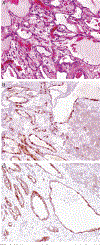Mesothelial neoplasms presenting as, and mimicking, ovarian cancer
- PMID: 20881862
- PMCID: PMC8375562
- DOI: 10.1097/PGP.0b013e3181e6a3ee
Mesothelial neoplasms presenting as, and mimicking, ovarian cancer
Abstract
Mesotheliomas of the abdominal cavity are rare tumors that primarily involve the peritoneum, mesentery, and omentum. The involvement of the viscera is usually secondary to bulky and extensive serosal disease. We describe 7 cases of mesothelioma in which the initial manifestation was that of an ovarian mass. All patients underwent surgery with a primary diagnosis of ovarian cancer. Clinical histories, gross features, and histology slides were reviewed. Immunostains were performed on all cases and electron microscopy was performed in 2 cases. The patients ranged in age from 22 to 52 years and the lesions ranged in size from 3.8 to 9 cm. Of the 7 cases, 4 were predominantly cystic and 3 were solid. Histologically, all cystic tumors were multicystic mesothelioma, whereas the 3 solid tumors were diffuse malignant mesotheliomas. One patient had a borderline mucinous tumor with the mesothelioma occurring as a mural nodule, an association not described earlier. The oldest patient in this series had a diffuse malignant mesothelioma of the peritoneum with predominant ovarian surface involvement. Mesothelial neoplasms can present as ovarian masses in young women. Awareness of this presentation is important to establish appropriate management.
Figures



Similar articles
-
Malignant peritoneal mesothelioma presented as peritoneal adenocarcinoma or primary ovarian cancer: case series and review of the clinical and immunohistochemical features.Int J Clin Exp Pathol. 2012;5(5):472-8. Epub 2012 May 23. Int J Clin Exp Pathol. 2012. PMID: 22808303 Free PMC article. Review.
-
Malignant mesotheliomas presenting as ovarian masses. A report of nine cases, including two primary ovarian mesotheliomas.Am J Surg Pathol. 1996 Sep;20(9):1067-80. doi: 10.1097/00000478-199609000-00004. Am J Surg Pathol. 1996. PMID: 8764743
-
Localized and diffuse mesotheliomas of the genital tract and peritoneum in women. A clinicopathologic study of nineteen true mesothelial neoplasms, other than adenomatoid tumors, multicystic mesotheliomas, and localized fibrous tumors.Am J Surg Pathol. 1995 Oct;19(10):1124-37. doi: 10.1097/00000478-199510000-00003. Am J Surg Pathol. 1995. PMID: 7573671
-
Well-differentiated papillary mesothelioma of the female peritoneum: a clinicopathologic study of 26 cases.Am J Surg Pathol. 2012 Jan;36(1):117-27. doi: 10.1097/PAS.0b013e3182354a79. Am J Surg Pathol. 2012. PMID: 22024662
-
From Krukenberg to today: the ever present problems posed by metastatic tumors in the ovary. Part II.Adv Anat Pathol. 2007 May;14(3):149-77. doi: 10.1097/PAP.0b013e3180504abf. Adv Anat Pathol. 2007. PMID: 17452813 Review.
Cited by
-
Sigmoid cancer mimicking ovarian echotexture on transvaginal ultrasound: Case report with literature review.Radiol Case Rep. 2020 Sep 28;15(11):2482-2492. doi: 10.1016/j.radcr.2020.09.041. eCollection 2020 Nov. Radiol Case Rep. 2020. PMID: 33014234 Free PMC article.
-
Malignant peritoneal mesothelioma presented as peritoneal adenocarcinoma or primary ovarian cancer: case series and review of the clinical and immunohistochemical features.Int J Clin Exp Pathol. 2012;5(5):472-8. Epub 2012 May 23. Int J Clin Exp Pathol. 2012. PMID: 22808303 Free PMC article. Review.
-
Primary Ovarian Mesothelioma: A Case Series with Electron Microscopy Examination and Review of the Literature.Cancers (Basel). 2021 May 10;13(9):2278. doi: 10.3390/cancers13092278. Cancers (Basel). 2021. PMID: 34068638 Free PMC article.
-
Benign multicystic peritoneal mesothelioma mimicking recurrence of an ovarian borderline tumor: a case report.J Med Case Rep. 2012 May 14;6:126. doi: 10.1186/1752-1947-6-126. J Med Case Rep. 2012. PMID: 22583977 Free PMC article.
-
Benign Multicystic Peritoneal Mesothelioma (BMPM) as a rare cause of abdominal pain: a case report and review of the literature.Int J Surg Case Rep. 2025 Jun;131:111448. doi: 10.1016/j.ijscr.2025.111448. Epub 2025 May 16. Int J Surg Case Rep. 2025. PMID: 40393365 Free PMC article.
References
-
- Boffetta P. Epidemiology of peritoneal mesothelioma: a review. Ann Oncol 2007;18:985–90. - PubMed
-
- Mohamed F, Sugarbaker PH. Peritoneal mesothelioma. Curr Treat Options Oncol 2002;3:375–86. - PubMed
-
- Alexander HR, Hanna N, Pingpank JF. Clinical results of cytoreduction and HIPEC for malignant peritoneal mesothelioma. Cancer Treat Res 2007;134:343–55. - PubMed
-
- Eltabbakh GH, Piver MS, Hempling RE, et al.Clinical picture, response to therapy, and survival of women with diffuse malignant peritoneal mesothelioma. J Surg Oncol 1999;70:6–12. - PubMed
-
- Baratti D, Kusamura S, Nonaka D, et al.Multicystic and well-differentiated papillary peritoneal mesothelioma treated by surgical cytoreduction and hyperthermic intra-peritoneal chemotherapy (HIPEC). Ann Surg Oncol 2007;14:2790–7. - PubMed
Publication types
MeSH terms
Grants and funding
LinkOut - more resources
Full Text Sources
Medical

